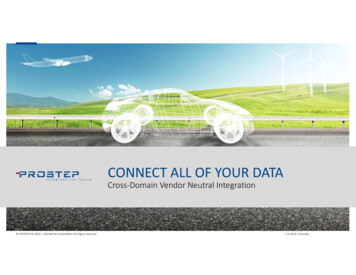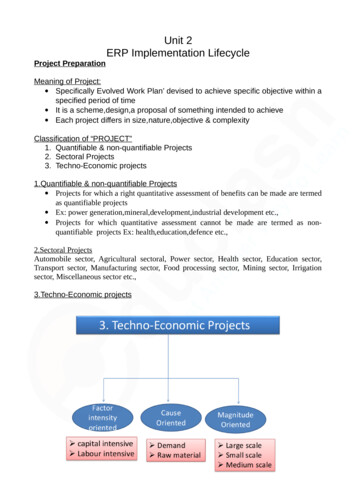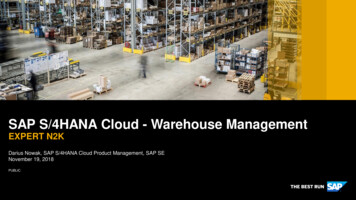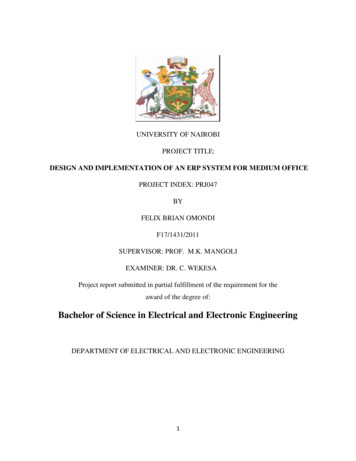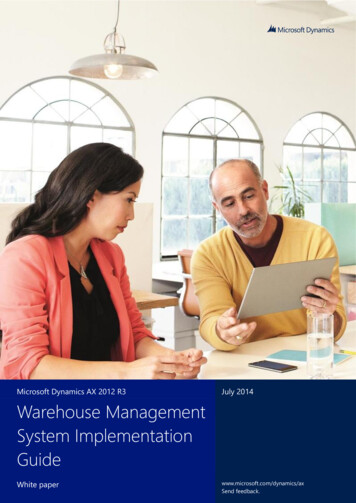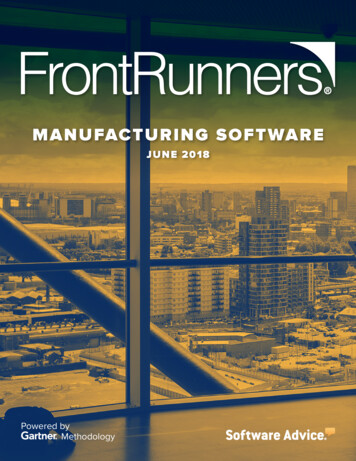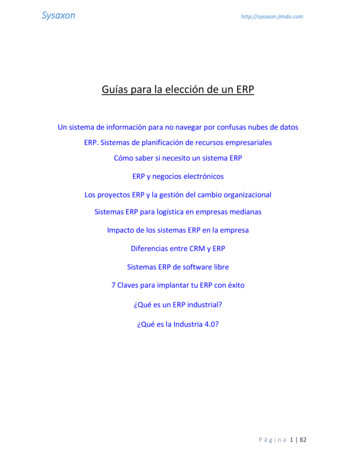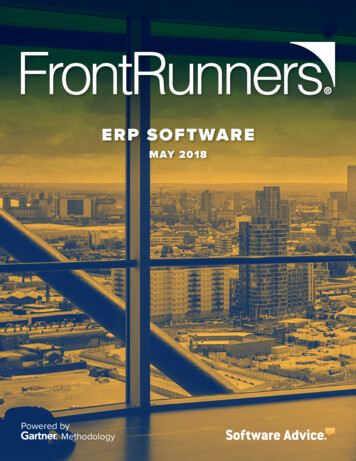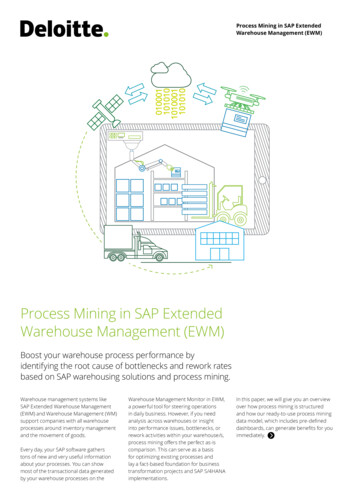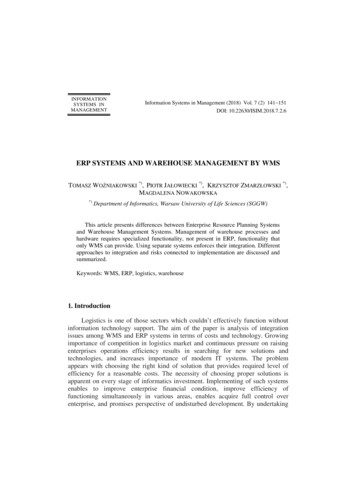
Transcription
INFORMATIONSYSTEMS INMANAGEMENTInformation Systems in Management (2018) Vol. 7 (2) 141 151DOI: 10.22630/ISIM.2018.7.2.6ERP SYSTEMS AND WAREHOUSE MANAGEMENT BY WMSTOMASZ WOŹNIAKOWSKI *), PIOTR JAŁOWIECKI *), KRZYSZTOF ZMARZŁOWSKI *),MAGDALENA NOWAKOWSKA*)Department of Informatics, Warsaw University of Life Sciences (SGGW)This article presents differences between Enterprise Resource Planning Systemsand Warehouse Management Systems. Management of warehouse processes andhardware requires specialized functionality, not present in ERP, functionality thatonly WMS can provide. Using separate systems enforces their integration. Differentapproaches to integration and risks connected to implementation are discussed andsummarized.Keywords: WMS, ERP, logistics, warehouse1. IntroductionLogistics is one of those sectors which couldn’t effectively function withoutinformation technology support. The aim of the paper is analysis of integrationissues among WMS and ERP systems in terms of costs and technology. Growingimportance of competition in logistics market and continuous pressure on raisingenterprises operations efficiency results in searching for new solutions andtechnologies, and increases importance of modern IT systems. The problemappears with choosing the right kind of solution that provides required level ofefficiency for a reasonable costs. The necessity of choosing proper solutions isapparent on every stage of informatics investment. Implementing of such systemsenables to improve enterprise financial condition, improve efficiency offunctioning simultaneously in various areas, enables acquire full control overenterprise, and promises perspective of undisturbed development. By undertaking
implementation of integrated information system the company gets uniqueopportunity to make significant organizational changes. These operations mayresult in raising efficiency not only everyday work organization, but magnitude ofresults depends on scale and range of changes [1].2. Enterprise Resource Planning systemsEnterprise Resource Planning (ERP) system is a package used for planningenterprise resources, composed of integrated modules which manage all of the corebusiness processes of the organization. Main objective of the system is toseamlessly incorporate business processes within and across the functional andtechnical boundaries in the organization with improved workflow, standardizationof business practice and access to up-to-date real time information. The basis of theERP system is database layer, DBMS common for all the modules, that managesthe operational and business data throughout the whole enterprise. The corefunctionalities include logistics management, manufacturing, sales and distribution,financial management, controlling, human resource management, projectmanagement, inventory management, service and maintenance, and managementreporting.ERP systems are very flexible and tailorable, allowing easily adaptation tospecific requirements of different organizations because business functionalities aredesigned as independent components, which can function separately. Privilegessystem allows to define user access for individual employees only to resources thatare related to their job’s responsibilities.Basic functional modules of ERP system including logistics managementconsist of: Sales and Distribution – part of large logistics area , supports customerrelationship from offer through the purchase order up to invoice. Thismodule is closely integrated with inventory management and productionplanning. Materials Management – this module is responsible for the coordination ofplanning, sourcing, purchasing, moving, storing and controlling materials Production Planning - manages the lifecycle of product manufacturingprocess according to customer requirements Quality Management – module manages planning and controlling productquality, collects quality data of raw materials, manufactured goods andfinished products. Plant Maintenance module for managing inspections, determining currenttechnical condition of equipment, preventive maintenance and keepingtechnical equipment in perfect condition [2].142
3. Main areas of risk by implementing ERP systemEvery company which plans to implement ERP system have to take intoconsideration specific risk level. The number of analysed risk areas should berestricted to areas that have main impact on results of the implementation.First is risk of not launching ERP system at all. This area describes a situationwhen as a result of different external reasons on side of IT system providerimplementation was cancelled or not completed with a fully operational andcommissioned deployment. Essentials of this risk area are expenses paid by thecompany for implementation ERP system. This cost should include not only initialoffer cost but also expenses on engaging company employees in theimplementation, or purchasing of servers and other IT hardware.Another risk area connected with implementing ERP system in company isbudget overrun. It is most common arising implementation risk, regardless of theclass of integrated IT system. It is very hard to avoid this course of events. In asituation when a project is highly advanced the management rarely decides not toallocate additional resource for full system implementation. That’s why IT systemsproviders often underestimate implementation costs in theirs offer or omitimportant expensive elements of the system, like future users’ training or projectadministration, counting on adjudicate additional funding after process of ITsystem implementation will start.Next area of risk in implementing an ERP class system is situation whencompany doesn’t achieve planned benefits from implementing ERP system. Duringmaking decision of implementing an ERP system, main and decisive factor is rangeof benefits for the company from an implementation of ERP system, That why thisrisk area should be considered as the most important amongst different risk areas.Probability of reaching planned business goals depends on functionalsophistication advance of the system, which manifests inability to meet businessrequirements.The last area of risk associated with implementing ERP informational systemis delay In implementation. This risk area resembles risk of no achieving plannedbenefits from implementation of ERP system. It refers to situation when systemERP was fully implemented, assumed business profits was achieved, but with aconsiderable delay e.g. 3-6 months. Factors which influence this risk area arequality of project management in implementing company.[3].4. WMS SystemWarehouse Management System (WMS) is an informational system dedicatedto manage entire high–volume warehouse operation in a real-time mode. Thesesystems are made to optimize supervision on handling and storage of products.143
Nowadays it is hard to imagine an efficient realization of logistics processeswithout IT tools that support them. The WMS program makes possible to quickreceipt and pick up goods at the warehouse, defines an external supplier orspecifies interior origin It controls goods in terms of quality and quantity andautomatically chooses storing location. The system specifies the shipping zone fororders marked for delivery, and analyses orders.The consequences of using these system functions are increase in companyturnover. Using such software makes possible to optimize tasks and realization ofoperations according to established priorities. As a result of implementing WMSsystem enterprise is supported in scopes of organization, supervision and control ofprocesses related to movement and storage of goods and materials.WMS have a number of specific features that accurately describe theirbehaviour. There will be optimization of storage space usage reduction of time for ordering and delivery of goods increasing of stock and assets turnover improving quality of services provided by manufacturers reduction amount of possible errors, due to advanced control and quickproblems resolution between manufacturers and merchants high flexibility and mobility in exchanging data with the system easier data access full control of orders management of warehouse traffic assistance in preparation of dispatch documentation and automation ofdispatch process automation of inventory process [4].5. Differences between ERP Warehouse module versus Best-of-Breed WMSBoth large and medium size manufacturing and distribution companies areaware of the fact that functioning without WMS system is difficult in competitivemarket. As far as ERP systems become standard in enterprise management, WMSsystem also becoming more important.Understanding the difference between WMS and ERP is very important forfunctioning of entire enterprise. Storage is last step during realization of customer’sorder and determines the level of satisfaction from collaboration with productsupplier.WMS are system specialized to support realization of warehouse processesand warehouse management. They possess advanced functionalities, but also havehigh cost and long implementation time. Respondents who marked using of this144
kind of solution were asked what was lacking in EPR warehouse modulesimplemented in theirs’ companies, that they decided to invest in separate WMSsystem. First they paid attention to greater flexibility of the WMS systems,possibility to dynamically manage pick locations and more efficient work withradio terminals. Surprisingly opinions of IT professionals and logistics have beendifferent. Logistics most frequently pointed out more flexibility and dynamism ofWMS systems, while the IT specialists opinions were more diverged and 40% hadproblem with answering this question and choose “hard to say” option.[5].Figure1. ERP warehouse module comparing to WMSSource: Systemy informatyczne w polskich magazynach, Raport 2014145
WMS during receiving goods uses advanced algorithms to optimize the place,time, and way to depositing goods, which is not supported by ERP. Logisticsprocesses are accomplished by creating task queues that include variousinterleaving operations, minimizing the empty cycles of forklift trucks. ERPsystems doesn’t work on queues, only on documents, which doesn’t contribute toincreasing efficiency of work. [6][9].Table 1. Use cases of ERP and WMSWMSERP if the company offers value-added services, such as kitting andassembly. It will need a specialized module for tracking this kind ofwork. if the company clients are demanding greater visibility intoinventory levels. Web portals that allow clients to view their inventorylevels using a standard browser are still the province of best-of-breedsolutions. If you need to improve reporting and accounting along withwarehousing operations. ERP suites offer an enterprise-wideperspective on warehousing and supply chain operations.Source: own preparation based on p-which-is-best-for-3pls/6. WMS and ERP integrationWarehouse management does not exist in isolation. WMS often includeintegration with hardware: barcode scanners, printers, labelling systems withexternal shipping companies or integration with an internal ERP software.Many warehouse operations, especially those with high-volume pick, packand ship requirements, include sophisticated automatic material handlingequipment which include conveyors, sorters, carousels, A-frame picking systems,pick-to-light systems. Most WMS solution offers extensive integrating with thesedevices.Most manufactures have a need for integrated item information, customerorders, inventory, shipment and visibility of incoming product. The degree towhich integration is necessary will vary depending on business needs. Integrationwith ERP implies that most software programs use a common database and mostinformation is updated in real time. While there are many examples of ERP andWMS software systems that are truly integrated, most third-party WMS productsare interfaced instead. Interfaced usually means the ERP system and WMS run onseparate databases, and perhaps on separate servers. In this case, duplication of a146
certain amount of business data is unavoidable, as well as additionalimplementation costs. Interfaces are usually accomplished with batch export andimport programs that physically transfer data between systems, or a middlewareproduct designed for this purpose. Even if these programs are included with theWMS or ERP package, during implementation may occur interface complexitiesand the need for custom interface development or interface issues that negativelyimpact the business.Figure 2. The industrial barcode scanner.Source: Making decision about purchasing separate WMS and ERP systems, differentintegration scenarios were considered. Purchase the WMS package offered by ERPvendor that was originally acquired from a third-party vendor and is now offered asan optional bolt-on to the ERP package. This is a very common situation since,over the years, many ERP vendors have rushed to provide a WMS solution to fillthis void. In order to make the WMS more compelling to potential customers, it islikely the new vendor spent plenty of time integrating or interfacing the systemwith its own ERP.Purchase a best-of-breed WMS from a third-party vendor. Because it needshigher-end software capabilities, this may be the only valid option for manycompanies. However, the software will likely cost more to purchase and definitely147
involves more custom interface expense. Also, using a middleware product to linkthe systems together will likely be a separate purchase [7].Risk area connected with failed integration means that there will besignificant amount of manual processing needed to keep data synchronized. So theeasiness of integration, time and costs to integrate should be taken intoconsideration when choosing the WMS system7. Using applications programming interfaces for integrationERP and WMS manufactures are aware of the fact that their systems will beconnected with other software. They offer different methods to extract and updatedata, including low-level programming languages in their software packages,providing Application Programming Interfaces (APIs), and documentation fordatabase schemas. The most popular high level communication method is SOAPbased web service.Figure 3. UML diagram of basic middleware application148
Web services use standardized XML messaging system to receive or sendrequests over the internet. Web services are platform independent, they are usingstandard protocols, can be implemented in any programming language. Definitionsof specified service are published using WSDL (Web Services DescriptionLanguage), an XML file which exposes service interface, interaction patterns andprotocol mapping. WSDL can be easily interpreted by other applications, but it ishard to read by humans. operation name "add" input name "addRequest" message "tns:addRequest" / output name "addResponse" message "tns:addResponse" / fault name "InsufficientPermissionFault"message "tns:InsufficientPermissionFault" / fault name "InvalidSessionFault"message "tns:InvalidSessionFault" / fault name "InvalidCredentialsFault"message "tns:InvalidCredentialsFault" / fault name "ExceededConcurrentRequestLimitFault"message "tns:ExceededConcurrentRequestLimitFault" / fault name "ExceededRequestLimitFault"message "tns:ExceededRequestLimitFault" / fault name "ExceededUsageLimitFault"message "tns:ExceededUsageLimitFault" / fault name "ExceededRecordCountFault"message "tns:ExceededRecordCountFault" / fault name "ExceededRequestSizeFault"message "tns:ExceededRequestSizeFault" / fault name "UnexpectedErrorFault"message "tns:UnexpectedErrorFault" / /operation Extract from SuiteTalk WSDL, defining web service for Oracle NetSuiteSource: https://webservices.netsuite.com/wsdl/v2017 1 0/netsuite.wsdlThat’s why many programming platforms offers assistants, which can readWSDL file and create ready to use methods and classes. For instance MicrosoftVisual studio enables adding “Web Reference” to project, automatically createsclasses and methods using definitions from WSDL file.Middleware applications use these automatically created classes to translatedata received from one system to format required by other system, usingpredefined values for missing data where complexity of ERP system far exceedsrange of information received from WMS system. Calling web service methodsmay fail, as a result of mismatched parameters, or unpredictable network problem,so all operation should be logged in local database.149
8. SummaryWMS systems have considerably changed with regard to technology as wellas amount of supported warehouse processes. For many years between the users ofthis systems classical approach prevailed – application should support typicalprocesses for instance magazine’s registers. During the years users’ requirementsgrew. Companies wanted support in loading, picking, releasing, scanning, labellingand monitoring workers activities. Today we have to deal with situation whensystem have to be closely adjusted to clients requirements. Often it has to cooperatewith industrial automation systems, because companies tend to fully automate theirwarehouses. Also grows importance of integration with data warehouses, carrierattendance applications, communications with subcontractors and stockmanagement. More frequently WMS is becoming a part of the ERP system. Todayintegration of WMS solutions with advanced IT systems is relatively simple. ERPand WMS systems are becoming more flexible. Task that were impossible or verydifficult few years ago, for instance implementing advanced ERP system in smallcompany became common practice. At development of WMS system greatinfluence has had mobile revolution, thank to which systems became easier to use –colourful application enables work with touch screen. Electronic informationexchange in supply chain, mobile data update, integration with transport andwarehouse automation have become standards.The role of WMS also changes, it has to not only support warehousemanagement but also enable to create more intelligent forms of management. Fromthis point of view WMS has to support more and more processes, it’s dutiesinclude scheduling tasks, allocating resources, managing transport automation andoptimizing storage space. Today the role of the system is full automation ofmagazine’s work, including adaptation to external conditions. More important ismathematical support, for instance by using optimization algorithms. Of course, wehave to remember that ERP never can replace WMS, just like ERP will not replaceERP system. There are two different solutions. ERP supports a number of businessprocesses, including supply chain. WMS only manages the warehouse. Theysupplement each other, and their integration brings the enterprise most profit [8].REFERENCES[1] Serafin E. Systemy informatyczne w logistyce, Logistyka 3/2014[2] Kanicki T. Systemy informatyczne w logistyce, Economy and Management 4/2011[3] Chwesiuk K. Analiza zastosowań systemów informatycznych klasy ERP w logistyce,Logistyka 4/2011[4] http://www.programyerp.com/wms150
[5] Systemy informatyczne w polskich magazynach, Raport 2014[6] s/when-the-erp-system-is-not-enough[7] -for-ERP-and-WMS-integration[8] le-ewolucji-systemow-klasy-wms[9] rp-which-is-best-for-3pls/151
SYSTEMS IN MANAGEMENT Information Systems in Management (2018) Vol. 7 (2) 141 151 DOI: 10.22630/ISIM.2018.7.2.6 ERP SYSTEMS AND WAREHOUSE MANAGEMENT BY WMS TOMASZ WOŹNIAKOWSKI *)*), PIOTR JAŁOWIECKI *), KRZYSZTOF ZMARZŁOWSKI, MAGDALENA NOWAKOWSKA *) Department of Informatics, Warsaw University of Life Sciences (SGGW)

